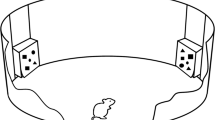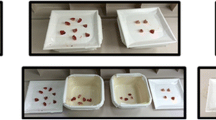Abstract
While numerosity—representation and enumeration of different numbers of objects—and quantity discrimination in particular have been studied in a wide range of species, very little is known about the numerical abilities of animals in the wild. This study examined spontaneous relative quantity judgments (RQJs) by wild North Island robins (Petroica longipes) of New Zealand. In Experiment 1, robins were tested on a range of numerical values of up to 14 versus 16 items, which were sequentially presented and hidden. In Experiment 2, the same numerical contrasts were tested on a different group of subjects but quantities were presented as whole visible sets. Experiment 3 involved whole visible sets that comprised of exceedingly large quantities of up to 56 versus 64 items. While robins shared with other species a ratio-based representation system for representing very large values, they also appeared to have developed an object indexing system with an extended upper limit (well beyond 4) that may be an evolutionary response to ecological challenges faced by scatter-hoarding birds. These results suggest that cognitive mechanism influencing an understanding of physical quantity may be deployed more flexibly in some contexts than previously thought, and are discussed in light of findings across other mammalian and avian species.





Similar content being viewed by others
References
Abramson JZ, Hernández-Lloreda V, Call J, Colmenares F (2011) Relative quantity judgments in South American sea lions (Otaria flavescens). Anim Cogn 14(5):695–706
Agrillo C, Dadda M, Serena G, Bisazza A (2008) Do fish count? Spontaneous discrimination of quantity in female mosquitofish. Anim Cogn 11:495–503
Agrillo C, Piffer L, Bisazza A (2010) Large number discrimination by fish. PLoS One 5:e15232
Barner D, Wood J, Hauser M, Carey S (2008) Evidence for a nonlinguistic distinction between singular and plural sets in rhesus monkeys. Cognition 107:603–622
Barth H, Kanwisher N, Spelke ES (2003) The construction of large number representations in adults. Cognition 86:201–221
Beran MJ (2001) Summation and numerousness judgments of sequentially presented sets of items by chimpanzees (Pan troglodytes). J Comp Psychol 115:181–191
Beran MJ (2008) The evolutionary and developmental foundations of mathematics. PLoS Biol 6:221–223
Beran MJ, Beran MM (2004) Chimpanzees remember the results of one-by-one addition of food items to sets over extended time periods. Psychol Sci 15:94–99
Burns KC, Steer J (2006) Dominance rank influences food hoarding in New Zealand Robins Petroica australis. Ibis 148:266–272
Cantlon JF, Brannon EM (2006) Shared system for ordering small and large numbers in monkeys and humans. Psychol Sci 17:401–406
Cantlon JF, Platt ML, Brannon EM (2009) Beyond the number domain. Trends Cogn Sci 13:83–91
Carazo P, Font E, Forteza-Behrendt E, Desfilis E (2009) Quantity discrimination in Tenebrio molitor: evidence of numerosity discrimination in an invertebrate. Anim Cogn 12:463–470
Carey S (2001) Cognitive foundations of arithmetic: evolution and ontogenesis. Mind Lang 16:37–55
Cheries EW, Mitroff SR, Wynn K, Scholl BJ (2008) Cohesion as a constraint on object persistence in infancy. Dev Sci 11(3):427–432
Clayton NS (1995) The neuroethological development of food-storing memory: a case of use it, or lose it. Behav Brain Res 70:95–102
Clayton NS, Krebs JR (1994) Memory for spatial and object-specific cues in food-storing and non-storing birds. J Comp Physiol 174:371–379
Clayton NS, Krebs JR (1995) Memory in food-storing birds: from behaviour to brain. Curr Opin Neurobiol 5:149–154
Clayton NS, Dally JM, Gilbert J, Dickinson A (2005) Food caching by western scrub-jays (Aphelocoma californica) is sensitive to the conditions at recovery. J Exp Psychol Anim Behav Process 31:115–124
Cook RG (2000) The comparative psychology of avian visual cognition. Curr Dir Psychol Sci 9:83–89
Dadda M, Piffer L, Agrillo C, Bisazza A (2009) Spontaneous number representation in mosquitofish. Cognition 112:343–348
Davis H, Memmott J (1982) Counting behaviour in animals: a critical evaluation. Psychol Bull 92:547–571
Dehaene S, Izard V, Spelke ES, Pica P (2008) Log or linear? Distinct intuitions of the number scale in Western and Amazonian indigene cultures. Science 320:1217
Farnsworth GL, Smolinski JL (2006) Numerical discrimination by wild Northern mockingbirds. Condor 108:953
Feigenson L, Carey S, Hauser MD (2002) The representations underlying infants’ choice of more: object files versus analog magnitudes. Psychol Sci 13:150–156
Feigenson L, Dehaene S, Spelke ES (2004) Core systems of number. Trends Cogn Sci 8:307–314
Gallistel CR, Gelman R (1992) Preverbal and verbal counting and computation. Cognition 44:43–74
Gallistel CR, Gelman R (2005) Mathematical cognition. In: Holyoak KJ, Morrison RG (eds) The Cambridge handbook of thinking and reasoning. Cambridge University Press, New York, pp 559–588
Hanus D, Call J (2007) Discrete quantity judgments in the great apes (Pan paniscus, Pan troglodytes, Gorilla gorilla, Pongo pygmaeus): the effect of presenting whole sets versus item-by-item. J Comp Psychol 121:241–249
Hauser MD, Carey S, Hauser LB (2000) Spontaneous number representation in semi-free-ranging rhesus monkeys. Proc R Soc Lond B Biol Sci 267:829–833
Honig WK, Stewart KE (1989) Discrimination of relative numerosity by pigeons. Anim Learn Behav 17:134–146
Hunt S, Low J, Burns KC (2008) Adaptive numerical competency in a food-hoarding songbird. Proc R Soc Lond B Biol Sci 275:2373–2379
Irie-Sugimoto N, Kobayashi T, Sato T, Hasegawa T (2009) Relative quantity judgment by Asian elephants (Elephas maximus). Anim Cogn 12:193–199
Jordan KE, Brannon EM (2006) A common representational system governed by Weber’s law: Nonverbal numerical similarity judgments in 6-year-olds and rhesus macaques. J Exp Child Psychol 95:215–229
Koehler O (1941) Vom Erlernen unbenannter Anzahlen bei Vögeln/The learning of unnamed amounts in birds. Naturwissenschaften 29:201–218
Lipton JS, Spelke ES (2003) Origins of number sense: large-number discrimination in human infants. Psychol Sci 14:396–401
Low J, Burns KC, Hauber ME (2009) Wild number sense in brood parasitic Brown-headed Cowbirds. Ibis 151:775–777
Lyon BE (2003) Egg recognition and counting reduce costs of avian conspecific brood parasitism. Nature 422:495–499
McComb K, Packer C, Pusey A (1994) Roaring and numerical assessment in contests between groups of female lions, Panthera leo. Anim Behav 47:379–387
McGavin S (2009) Density and pair fidelity in a translocated population of North Island robin (Petroica longipes). Notornis 56:206–212
Meck WH, Church RM (1983) A mode control model of counting and timing processes. J Exp Psychol Anim Behav Process 9:320–334
Menzies IJ, Burns KC (2008) Food hoarding in the New Zealand robin: a review and synthesis. In: Weber EA, Krause LH (eds) Animal behavior: new research. Nova Science Publishers, New York, pp 163–183
Pepperberg IM (2006) Grey parrot (Psittacus erithacus) numerical abilities: addition and further experiments on a zero-like concept. J Comp Psychol 120:1–11
Rugani R, Regolin L, Vallortigara G (2008) Discrimination of small numerosities in young chicks. J Exp Psychol Anim Behav Process 34:388–399
Shettleworth SJ (2010) Cognition, evolution, and behavior, 2nd edn. Oxford University Press, New York
Terrace HS (1987) Chunking by a pigeon in a serial learning task. Nature 325:149–151
Trick LM, Pylyshyn ZW (1994) Why are small and large numbers enumerated differently? A limited-capacity preattentive stage in vision. Psychol Rev 10:80–102
Uller C (2008) Developmental and evolutionary considerations on numerical cognition: a review. J Evol Psychol 6:237–253
Uller C, Jaeger R, Guidry G, Martin C (2003) Salamanders (Plethodon cinereus) go for more: rudiments of number in an amphibian. Anim Cogn 6:105–112
van Marle K, Wynn K (2011) Tracking and quantifying objects and non-cohesive substances. Dev Sci 14(3):502–515
Vander Wall SB (1990) Food hoarding in animals. University of Chicago Press, Chicago
vanMarle KL, Aw J, McCrink K, Santos LR (2006) How Capuchin monkeys (Cebus apella) quantify objects and substances. J Comp Psychol 120(4):416–426
White DJ, Ho L, Freed-Brown G (2009) Counting chicks before they hatch: female cowbirds can time readiness of a host nest for parasitism. Psychol Sci 20:1140–1145
Acknowledgments
We thank the Karori Sanctuary staff and volunteers for making this research possible.
Author information
Authors and Affiliations
Corresponding author
Rights and permissions
About this article
Cite this article
Garland, A., Low, J. & Burns, K.C. Large quantity discrimination by North Island robins (Petroica longipes). Anim Cogn 15, 1129–1140 (2012). https://doi.org/10.1007/s10071-012-0537-3
Received:
Revised:
Accepted:
Published:
Issue Date:
DOI: https://doi.org/10.1007/s10071-012-0537-3




